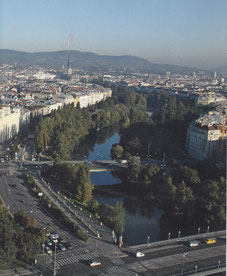
Donaukanal, the Danube Canal was the main arm of the Danube River. For a long time it had the name Wiener Arm which means "The Viennese arm". Instead, today this channel is only a side arm of the Danube River which flows about two kilometers away. Since the great river regularisation in 1875, most of Vienna, including the Old Town, has been well isolated from the main Danube channel. The waters that once slaps the walls of the Altstadt and regularly flooded the strips of land and islands of the Leopoldstadt, are led across the Donaukanal in a semi-circle from Nussdorf on the north-west side of Vienna to Praterspitz in the east.
There are about twenty kilometers with many attractions for tourists and also with a beautiful bike path. But the river did not initially have this regular semicircular shape with the banks in almost rectilinic forms. The Danube flowed in a riverbed between two and six kilometers wide and caused a lot of damage and severe flooding. The river carries a large amount of sand, stones and debris as the difference in height in the Wiener Becken (the Vienna basin) is very low and so the speed of the current is almost minimal. For this reason the Danube has a large amount of sedimentation which determine silting. This always moves the river in the direction of Marchfeld. To avoid floods and damage, extensive Danube regulation projects were created that lasted for the past 120 years. Only in this way was it possible to stop the floods and the movement of the Danube bed. There were many floods of the great and cruel Danube which made many problems like cholera epidemics. But the only navigable arm was this Danube Canal and the Viennese wanted a navigable canal and worked on its conservation starting in the fifteenth century.
So in the time of the Wiener Kongress (the Viennese Congress) the city of Vienna presented the first regulation projects for the Danube. A few years later, there was a lot of moving ice on the Danube and the river has almost become a stream of ice. But only after thirty years was there a complete project for the regulation of the Danube. Initially this project had to be dealt with and accepted by the imperial administration, the city of Vienna and the administrative region from Lower Austria because the Danube flows in all these territorial regions. The Danube regulation program contained the construction of a new main straight arm but with navigation on the Danube canal. This was also a program to protect the Danubian cover-up canal. The previous main arm is now very close to the UNO City Vienna and is called Alte Donau which also means that the old Danube is a stagnant water as protection against flooding, so almost a drainage basin.
A Viennese vaporetto?
In 2007, before the European Football Championships, the city government discussed the possibility of setting up a Viennese vaporetto and starting a water taxi service that should have served on the Donaukanal and the Danube itself. But Vienna is not Venice and the project was surrounded by an aura of impossibility.
The Danube Canal Tour
We rent a bike and start our tour north of the Canal with the Schemmerl bridge designed by Otto Wagner, we turn south along the canal to see the incinerator decorated by Hundertwasser in Spittelau, we cycle along the canal in Vindobona, today the Old Town, where we admire the old Romanesque church Ruprechtskirche on the right and modern architecture with the skyscrapers on the left (like the UNIQA tower). We see on our left on the bank of the Danube canal a small park called the "Riviera del Danube (where there is also a Strandbar) which is called Hermannpark. Immanuel Hermann was a minister who lived in the nineteenth century and was also the inventor of the postal card in Austria. Then we pedal fast on our Hundertwasser tour to see the Museum, the DDSG pontoon pavilion and the Hundertwasser House. After a coffee we cycle to Prater to see the Lusthaus.
Welcome to our theatrical, musical city, historical Habsburg court residence which is also a village with an incredible mix of ethnicity. Welcome to our "Experimental Laboratory for the End of the World" as Karl Kraus wrote. But instead of that Vienna would today be an experimental laboratory to avoid the end of the world.
© 2020 Nicoleta Schiel























